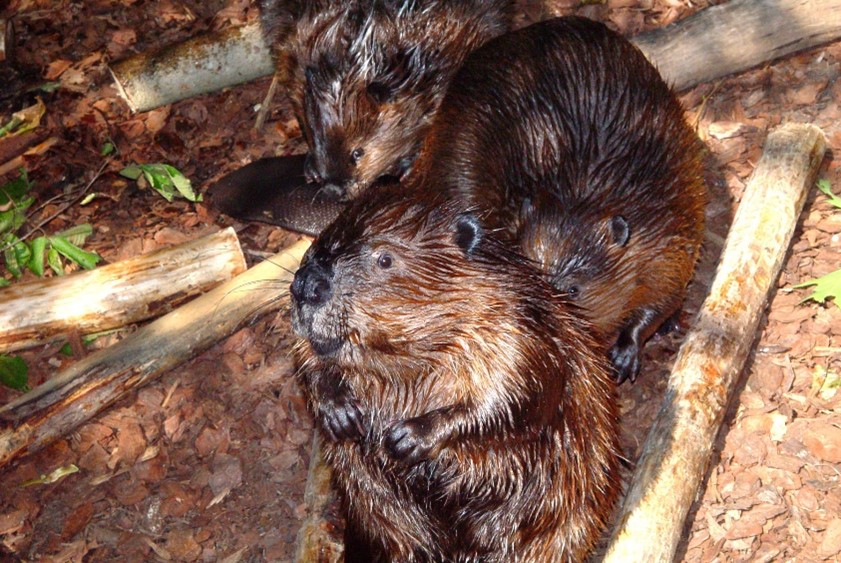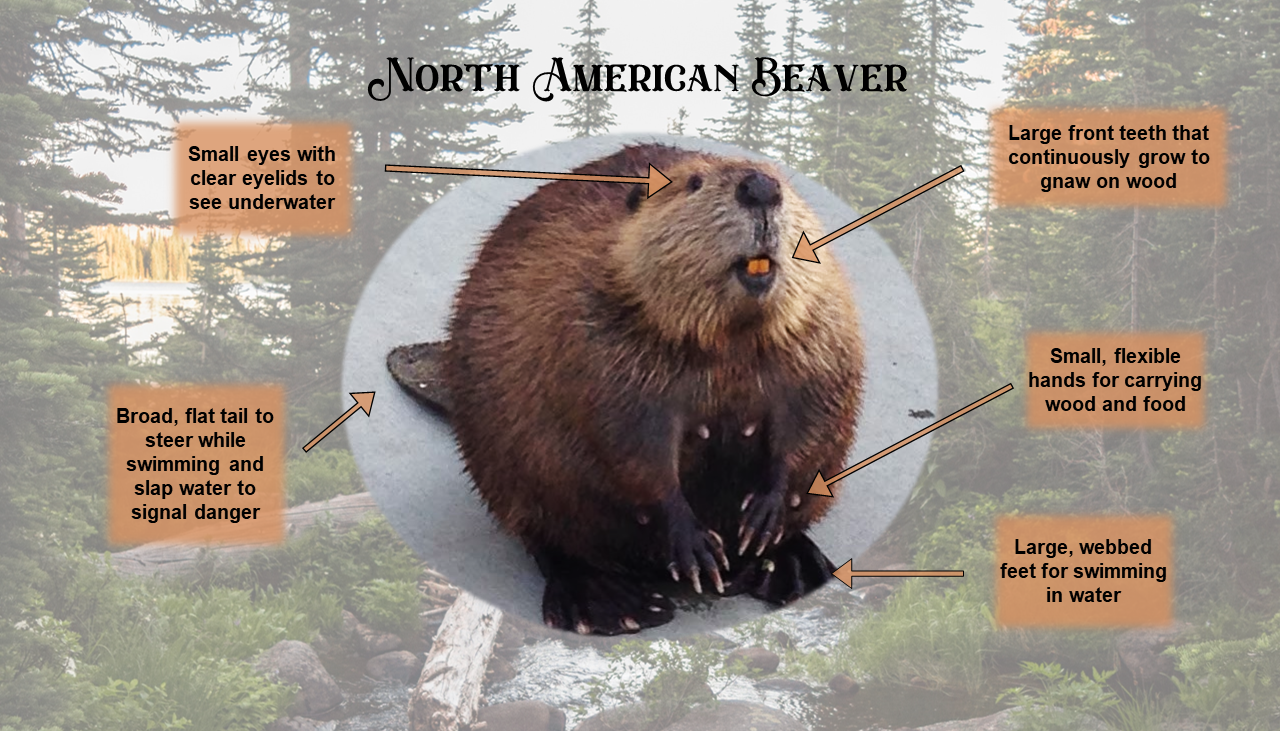North American Beaver
- Scientific Name: Castor canadensis
- Niimíipuu Name: Táx̣cpol
 Description:
Description:
The genus Castor has two species: Castor canadensis (North America) and Castor fiber (Eurasia). The North American beaver has 24 subspecies with a mixture found across North America due to reintroductions of different beavers to various regions. The dominant subspecies along the Nez Perce (Nee-Me-Poo) National Historic Trail is Castor canadensis concisor, with the subspecies Castor canadensis taylori also found along the Snake River drainage.
 The North American beaver ranges in size, but some of the largest beavers reach up to 4 feet long and weigh up to 70 pounds! They are muscular with a teardrop-shaped body, which is broadest along the hips. Beavers have small round eyes and a large head that is held up by a thick neck. Their fur is long and coarse to repel dirt and water with fur color ranging from black/dark brown to reddish-brown. Both limbs have five digits, but the forelimbs are smaller than the hind. The forefeet are clawed for digging and flexible so they can carry food and supplies, and the hindfeet are webbed to swim in the water efficiently. One of the most distinctive features on a beaver is their broad and flat tail, which is primarily used for fat storage and communication. Put together, and the beaver is highly specialized for a semi-aquatic lifestyle. In the water, they use their webbed hindfeet to propel themselves and the tail to steer. Also, they have transparent eyelids and valves that shut off their ears and nose to protect them from the water. On the land, the tail is used for balance while food and other materials are carried with the forefeet.
The North American beaver ranges in size, but some of the largest beavers reach up to 4 feet long and weigh up to 70 pounds! They are muscular with a teardrop-shaped body, which is broadest along the hips. Beavers have small round eyes and a large head that is held up by a thick neck. Their fur is long and coarse to repel dirt and water with fur color ranging from black/dark brown to reddish-brown. Both limbs have five digits, but the forelimbs are smaller than the hind. The forefeet are clawed for digging and flexible so they can carry food and supplies, and the hindfeet are webbed to swim in the water efficiently. One of the most distinctive features on a beaver is their broad and flat tail, which is primarily used for fat storage and communication. Put together, and the beaver is highly specialized for a semi-aquatic lifestyle. In the water, they use their webbed hindfeet to propel themselves and the tail to steer. Also, they have transparent eyelids and valves that shut off their ears and nose to protect them from the water. On the land, the tail is used for balance while food and other materials are carried with the forefeet.
 Beavers are well known for their construction of dams. Dams are built to stop and accumulate water to expand their ideal habitat, increase food supply, protect them from predators, and provide enough water for winter survival. They can build the dams with wood by using their long, chisel-shaped orange incisors to cut branches and trees and then carry the building supplies with their forefeet. The incisors continue to grow, so the beavers never run the risk of wearing down their front teeth and can always gnaw on wood.
Beavers are well known for their construction of dams. Dams are built to stop and accumulate water to expand their ideal habitat, increase food supply, protect them from predators, and provide enough water for winter survival. They can build the dams with wood by using their long, chisel-shaped orange incisors to cut branches and trees and then carry the building supplies with their forefeet. The incisors continue to grow, so the beavers never run the risk of wearing down their front teeth and can always gnaw on wood.
 In addition to dams, beavers construct multi-chamber lodges out of wood and mud in shallow water for shelter. Lodges tend to be found along banks with the entrance underwater. The first internal chamber is used for feeding, while the second chamber is located higher up, so it is dry and warm. The second chamber is where beavers sleep and rear their offspring, called kits.
In addition to dams, beavers construct multi-chamber lodges out of wood and mud in shallow water for shelter. Lodges tend to be found along banks with the entrance underwater. The first internal chamber is used for feeding, while the second chamber is located higher up, so it is dry and warm. The second chamber is where beavers sleep and rear their offspring, called kits.
Beavers tend to live in family colonies composed of an adult breeding pair, their new offspring (kits), and the offspring from the previous year. The family colony lives in a lodge together, with the adult female initiating activities such as building the dam, lodge, or food cache. Independently, beavers will cut wood, build, and defend their territory if it is needed. They communicate with each other by slapping their tails on the water surface to warn others in their colony of danger or to scare predators away. In general, these activities take place at night since they are nocturnal.
Habitat and Food:
Beavers live in a wide variety of habitats since they can modify the environment to fit their needs. However, at a minimum, they require a permanent body of water with an adequate food supply. You can find beavers throughout most of North America except for the Alaskan tundra, South Carolina, some areas of the Midwest, and the Florida peninsula.
Beavers are foragers, so they gather food and carry it back to their territory or lodge for consumption. They are herbivores with their diet primarily consisting of leaves, twigs, bark, and aquatic vegetation. One of their favorite trees to consume are willows since the bark is high in protein and easily digestible.
Mythology:
The beaver is a prominent creature in multiple native legends. One Nez Perce legend is called How the Beaver Stole Fire:
Animals and trees used to communicate like humans and walked around the landscape. During this time, Pine Trees were the only ones who could make fire and refused to tell any other species how to make it, despite the freezing winters. During one of these cold winters, a council of Pine Trees met along the Grande Ronde River and made a large fire with guards so no one could steal the fire. However, the beaver hid until a lump of hot coal rolled down to the riverbank, and the beaver grabbed it and ran away. The Pine Trees chased the beaver, but he dodged them by moving side to side and running straight ahead, which is why sections of the Grande Ronde River weaves and is straight in some areas. Eventually, the Pine Trees grew tired and stopped, so the river has dense forests along the riverbanks. The beaver swam across the river, where the Grande Ronde River joined the Snake River and gave fire to the Birches and other trees. The beaver is to thank for why animals and humans can make fire by rubbing two pieces of wood together.
The North American beaver is a semi-aquatic mammal and the largest rodent in North America. The North American beaver was named the Oregon state animal in 1969, so Oregon’s nickname is the “Beaver State.” Beavers are unique from other species since they create dams, which modifies the environment by building up water and preventing soil erosion. Beaver was considered a delicacy by the Nez Perce and they made their teeth into necklaces. Some Nez Perce also hunted them and sold their pelts to support their families.
Sources:
Boyle, S. & Owens, S. 2007. North American Beaver (Castor canadensis): A Technical Conservation Assessment [Online]. UDSA Forest Service, Rocky Mountain Region. Available: http://www.fs.fed.us/r2/projects/scp/assessments/northamericanbeaver.pdf
Judson, K.B. 1910. Myths and legends of the Pacific Northwest, especially of Washington and Oregon. McClurg, Chicago. Available: https://archive.org/details/mythslegendsofpa00judsuoft/mode/2up
Smith, R. & Smith, M. 2003. B Is for Beaver: An Oregon Alphabet. Sleeping Bear Press, China.

